Physical Address
304 North Cardinal St.
Dorchester Center, MA 02124
Anthrax, caused by Bacillus anthracis, is a devastating disease for humans and animals, and one of the most important bioweapons. Though rare in the United States, natural anthrax exposure occurs sporadically worldwide. Anthrax most often manifests as cutaneous or gastrointestinal (GI) disease, with inhalation anthrax (IA) being associated with bioterrorism. Once diagnosed, anthrax must be aggressively treated with an antimicrobial regimen of fluoroquinolones, tetracycline, imipenem or some other penicillin, and supportive ICU care. Anthrax immune globulin is available from the US Centers for Disease Control (CDC) as an adjunct for IA treatment, as well as commercially available monoclonal antibodies. A licensed vaccine is available, and a new vaccine is approaching licensure. Prognosis for survival is relatively high for treated cutaneous (<1% mortality when treated) and GI anthrax (0% to 29% mortality). IA, even when treated early and aggressively, has a high mortality rate (45% in the 2001 “Amerithrax” attacks). Prevention and mitigation of this disease depend on the control of anthrax in animals, restriction or decontamination of animal products, and preparedness for rapid public health response to bioterrorism events.
Three senior officials fall ill the night before a major diplomatic event at a foreign embassy, including the ambassador. The following morning, a major treaty governing a lucrative rare-metals extraction contract is scheduled to be signed. All three report fever, chills, headache, and myalgia, with one reporting GI distress. The ambassador’s condition deteriorates overnight, and by morning he is barely responsive with profuse vomiting and diarrhea. The other two have increasing GI distress and at least one has mild ascites. Three other individuals have fallen ill as well. The event is cancelled, and an emergency response team brought in from the host country. Local law enforcement is notified that a member of the kitchen staff has not reported to work in 3 days. One of the other food handlers is noted to have a pruritic, painless papule on the left hand.
As the day progresses, the ambassador and one other staff member deteriorate and lapse into a coma. Evacuation to a local hospital reveals both to be in septic shock, with severe abdominal tenderness diffusely. Both are started on life support and empiric broad-spectrum antibiotics, with activity against potential enteric pathogens. The conditions of the others continue to deteriorate over the next 48 hours.
COMMENT: A high index of suspicion is necessary to diagnose acute anthrax, particularly from non-classical forms. In this case, GI anthrax might be confused with other enteric pathogens commonly associated with food poisoning. The severity of the presentation, timing around a sensitive diplomatic event, and the epidemiologic patterns observed should all raise suspicion for a deliberate bioterrorist attack. This is the most likely setting where inhalational and GI anthrax are likely to be observed. Diagnosis can be difficult and may be delayed. Rapidly assessing the situation and implementing appropriate empiric treatment are essential to saving lives.
Anthrax is a globally distributed zoonotic disease, primarily affecting livestock and wild herbivores, though more common today in Africa, Asia, and Central America. Sporadic animal outbreaks and rare human cases continue to occur elsewhere. Occasional B. anthracis outbreaks have been associated with war and drought conditions throughout history, starting with description of plagues appearing in the Bible’s Old Testament. Most recently, an extended outbreak in the late 1970s killed more than 10,000 individuals in Zimbabwe following years of war. Modern-day anthrax occurs primarily in grazing animals including sheep, goats, and other domesticated species, as well as hippos, rhinos, and other wild herbivores. Sporadic human cases largely result from contact with infected animal carcasses causing the cutaneous form, or ingestion of contaminated meat leading to GI anthrax. Whether disease spread is primarily from anthrax spores persisting in the soil or from infected animal carcasses remains unsolved. Aerobic conditions in decaying tissues are thought to promote spore formation, and spores are known to persist in soil for decades, particularly in dry conditions when risk of transmission increases. More recently, outbreaks among intravenous drug users—with both cutaneous and septicemic anthrax from infected needles and heroin—have been reported in Scotland and Norway.
B. anthracis is a rather large, aerobic, non-motile, gram-positive rod 1 to 2 microns in length and often appearing in chains of two to three organisms. On sheep’s blood agar, thick, flat 2 to 5 mm gray-white colonies appear after incubation at 37 degrees for 15 to 24 hours. It grows best with carbon-dioxide enrichment, and is lysed by an anthrax-specific, gamma-delta bacteriophage ( Fig. 90.1 ). It was the first causative organism identified for a bacterial disease by Robert Koch in 1877. Anthrax sporulates in settings of stress to include increasing oxygen tension, particularly in animal carcasses, which then contaminate the soil where they may survive for decades—particularly in dry conditions.
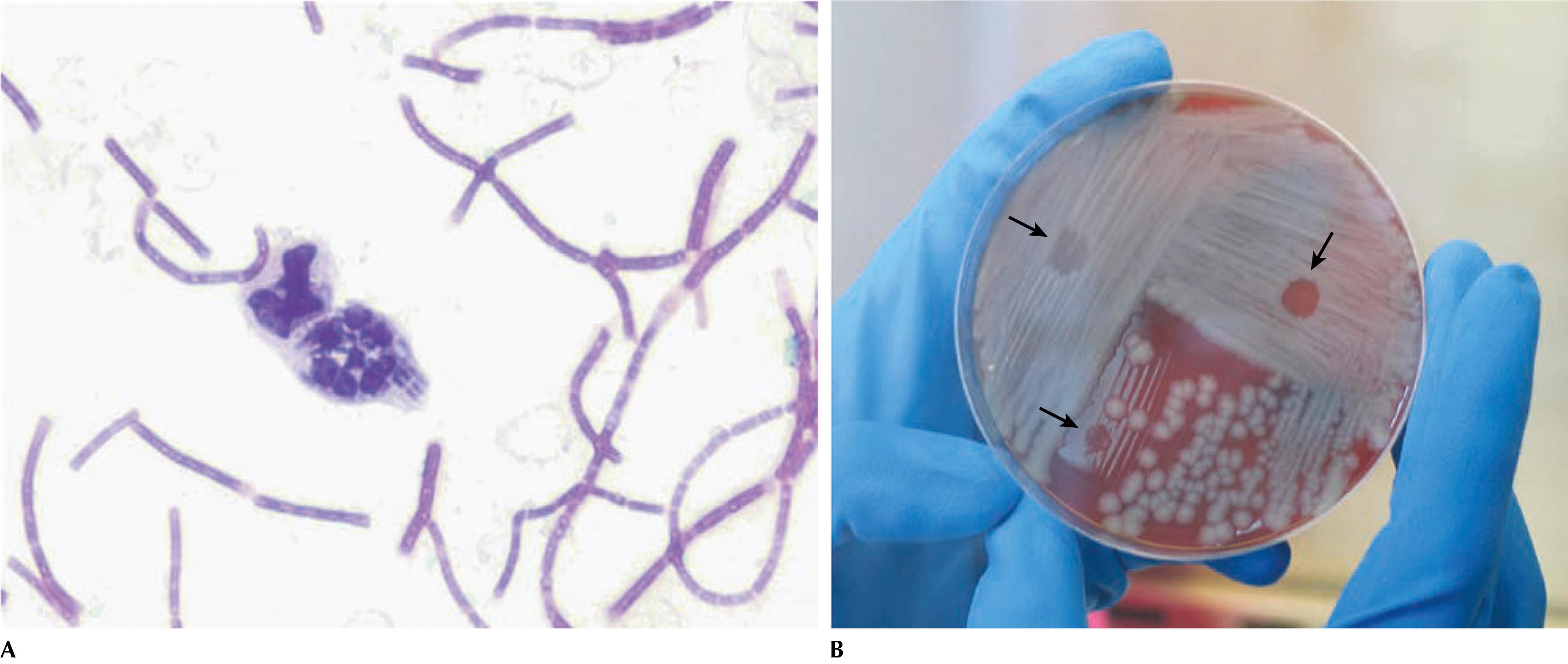
Anthrax spores enter the body primarily by three routes: skin abrasions, ingestion, and inhalation. A rare form of entry has been identified in Europe by drug injection, usually heroin. Once anthrax spores enter the body, they are phagocytosed by macrophages, wherein they germinate into vegetative bacteria or bacilli, released from macrophages into regional lymphatics where they multiply and enter into the bloodstream causing massive septicemia.
The vegetative form expresses potent virulence factors, including two binary exotoxins and a capsule coded in two plasmids, pXO1 and pXO2. The resulting toxemia can cause organ failures and host death. The plasmid pXO1 codes for three factors: protective antigen (PA), lethal factor, and edema factor, that produce the two binary exotoxins. The two binary exotoxins are lethal toxin (LT) , consisting of PA and lethal factor, and edema toxin (ET) , consisting of PA and edema factor. PA binds to a receptor on target cells where it is subsequently cleaved and forms a heptamer. PA heptamer binds three molecules of LT and ET and transports them into the interior of the cell where these toxins exert their biologic actions ( Fig. 90.2 ).
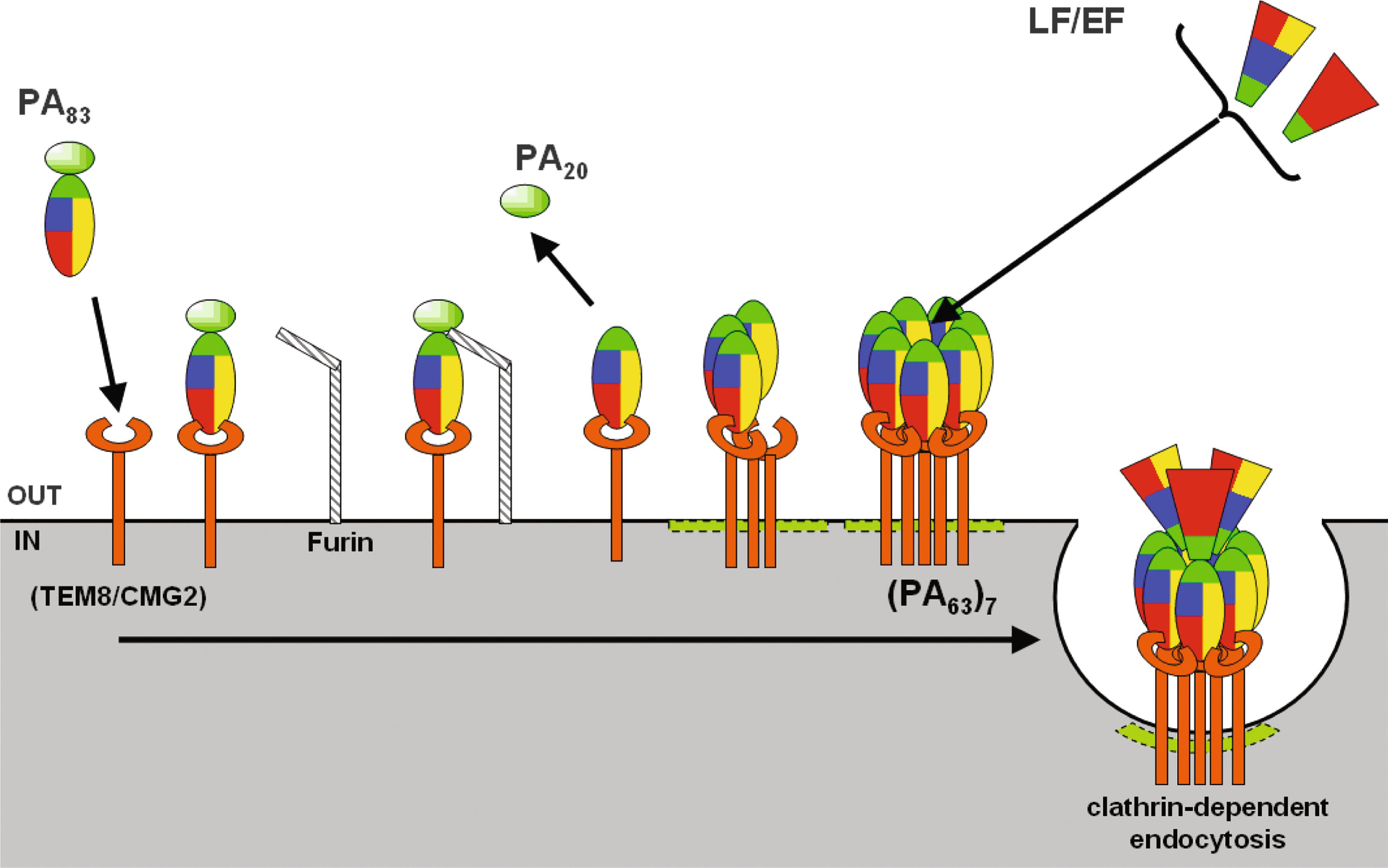
LT is lethal to macrophages causing lysis and release of toxic cytokines including interleukin-1, tumor necrosis factor-α, and others. LT stimulates apoptosis in endothelial cells causing vascular leak syndromes, while inhibiting multiple normal immune cell line responses. In addition to causing local edema, ET impairs multiple normal immune cell responses including phagocytosis, cytokine production by macrophages, and dendritic cell function.
The plasmid, pXO2, the smaller of the two plasmids, carries the genes that produce the poly-glutamyl capsule. Historically, the capsule is noted to inhibit phagocytosis of the bacilli, whereas the exotoxins are involved in inhibiting the host’s innate and acquired immune responses against infection. Both pXO1 and pXO2 are required for virulence; deleting one or both results in attenuation of B. anthracis.
The relative dose of anthrax spore exposure and local immunologic interactions appear to influence the course of disease and may explain, at least in part, the far higher lethality of inhalational disease. Cutaneous infection appears to be rapidly walled off, and largely limited to local infection, though systemic spread can sometimes occur if untreated. Spores are not thought to germinate in the alveolar spaces following initial exposure, but are rather translocated to regional hilar lymph nodes where they vegetate, encapsulate with accompanying virulence factor expression, and rapidly multiply. This leads to massive tissue damage and rapid systemic spread leading to septic shock ( Fig. 90.3 ).
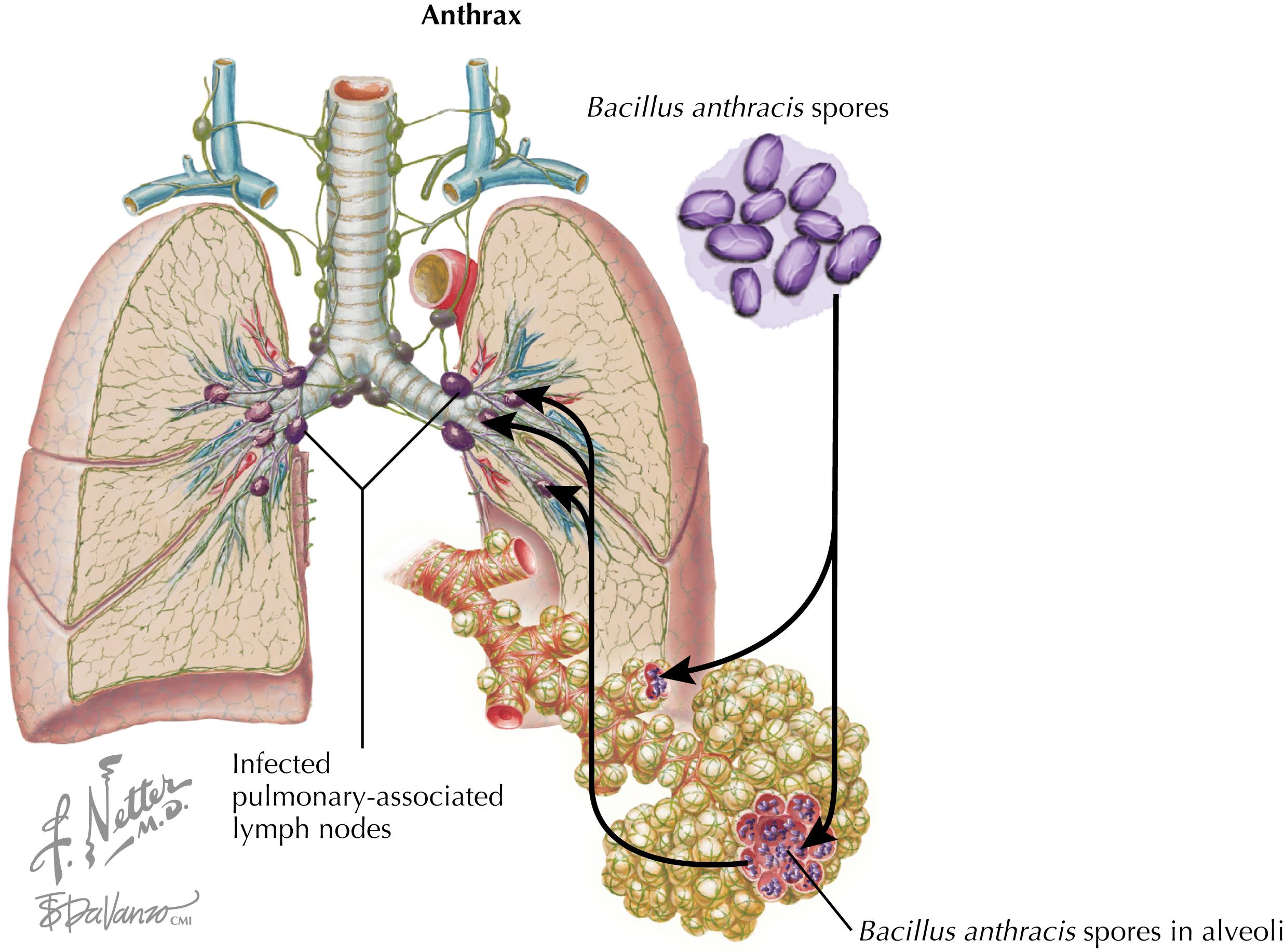
Bacillus cereus , normally associated with GI food poisoning, has also been found in rare instances to cause human disease similar to anthrax. This suggests possible recombination in the environment, and may further complicate diagnostic efforts.
The major clinical presentations of B. anthracis infection are shown in Fig. 90.4 . Though occurring in some agro-industrial settings in the past, such as wool sorters and tanners, with up to 100,000 cases estimated worldwide in 1958, the most serious inhalational form of anthrax is exceedingly rare today following improvements in industrial hygiene. There were only 400 anthrax cases, largely cutaneous, over the second half of the 20th century in the United States. Naturally occurring anthrax is now exceedingly rare in the United States, with only one case per year reported on average in the last 2 decades. These occur predominantly in those working with animal products including hides, drums, wool, hair, and the meat from infected animals. IA is at present most likely to occur from deliberate bioterrorist aerosol attack. The most striking example were the “Amerithrax” attacks in 2001 in Washington, D.C., which caused 11 cutaneous and 11 inhalational cases. Five of the 11 inhalational patients died, despite aggressive intensive care and appropriate antibiotic therapy. An accidental release of weapons-grade anthrax from a factory in Sverdlovsk, Russia in 1979, is believed to have caused more than 100 human deaths and killed livestock downwind of the factory. Though 96 cases with 64 deaths were eventually confirmed officially, the incident was covered up for years by Soviet authorities. Anthrax was used by Germany against enemy livestock in World War I. Japan used anthrax as an antipersonnel weapon in Manchuria as well as in World War II.
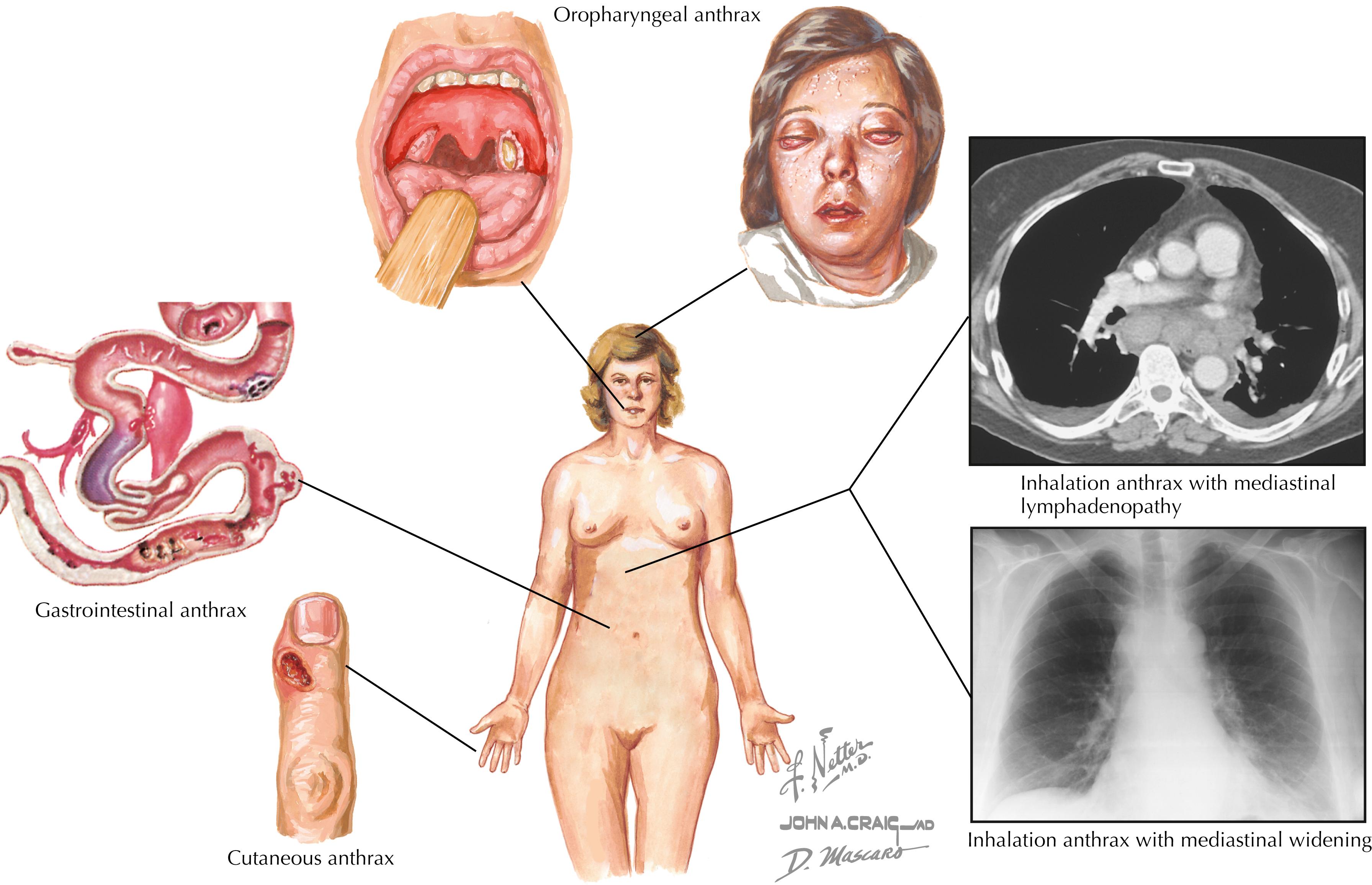
A small amount of B. anthracis , estimated at inhalation of 8 to 10,000 spores, may be fatal. Covert experiments with the spores of similar but nonpathogenic organisms demonstrated the ease of wide dissemination of potentially lethal anthrax spore concentrations using Serratia marcescens across the San Francisco Bay area in 1950, and Bacillus globigii in the New York City subway system in 1966. Because of its aerosol infectivity at very low doses, environmental persistence, lethality, and relative ease of manufacture and dissemination, B. anthracis is categorized as a Tier 1 bioterrorism agent by the US CDC, as well as a Category A select agent. Laboratory workers who handle anthrax must work in biosafety level 3 (BSL-3) containment conditions to limit the risk of exposure. Modern industrial hygiene practices have greatly lowered risks for workers handling animal products.
Cutaneous anthrax is most commonly seen in nature and results from local infection with anthrax spores. The spores germinate in the skin, often with regional adenitis, as organisms are taken up by local lymphatics. Lesions typically begin as a painless and/or pruritic papule 1 to 12 days after infection, emerging most commonly within 1 week. Peripheral lesions may appear as well, along with regional lymphangitis, systemic symptoms to include headache, malaise, and fever. Vesicular lesions will typically develop a central vesicle, which ruptures and ulcerates. The lesion progresses with development of black eschar, which persists for 2 to 3 weeks, leaving a scar that may require cosmetic reconstruction. Fig. 90.5 shows characteristic lesion with black eschar and surrounding edema. In rare cases, cutaneous disease may progress to systemic involvement, which should be treated in the same manner as IA. It is important not to assume that cutaneous disease arose solely from skin exposure, and patients should be monitored for systemic disease, particularly if etiology of skin lesions is unclear.
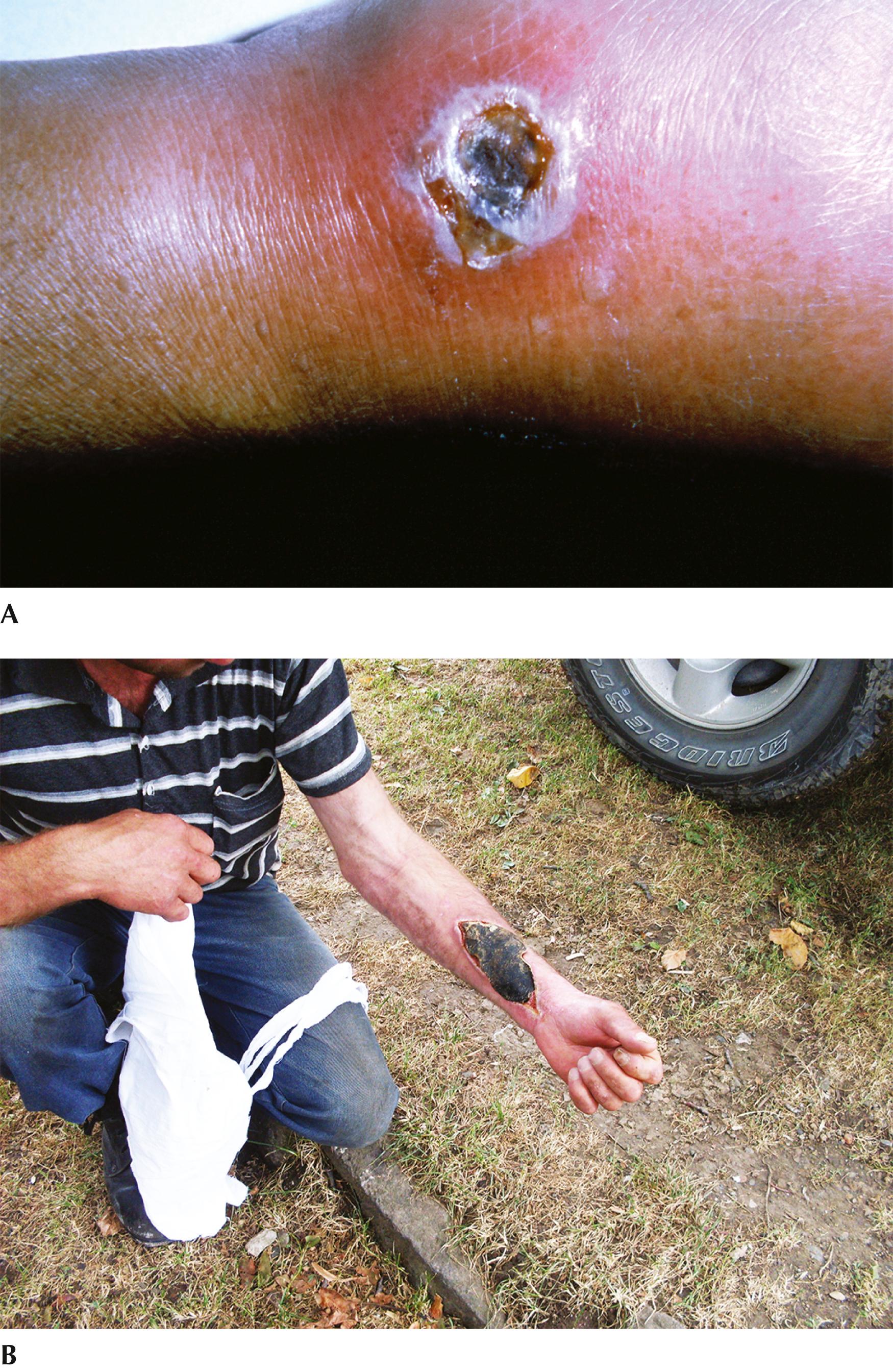
Become a Clinical Tree membership for Full access and enjoy Unlimited articles
If you are a member. Log in here